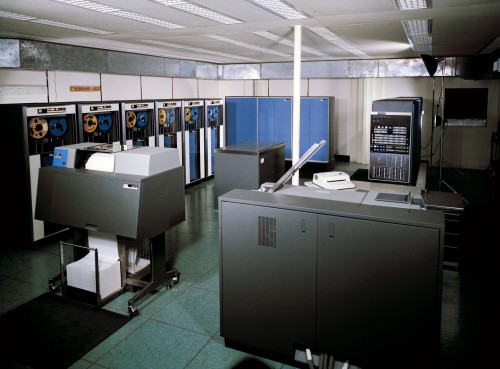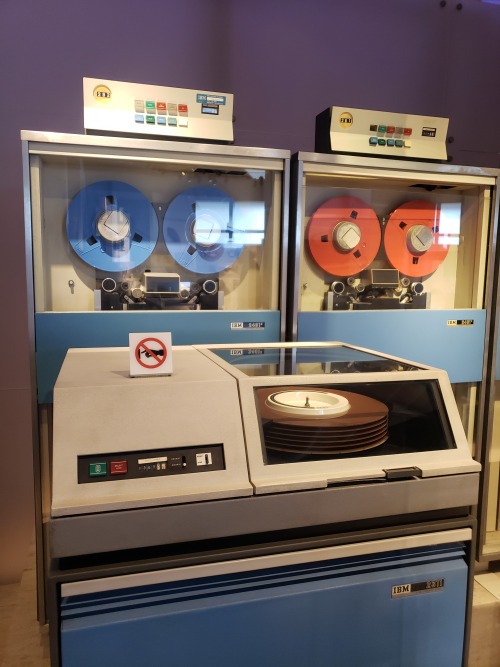3wivesoneidentificationcard - 3 Wives One Identification Card

More Posts from 3wivesoneidentificationcard and Others

instagram: cheri.png

IBM computers and other equipment at NASA's Johnson Space Center, 1963 (when it was called the Manned Spacecraft Center).


" Colorful Again 🍁 " // © Giulio Gröbert







🇺🇲 113 years ago, on June 16, 1911, the Computing-Tabulating-Recording Company (CTR) was formed by merging three smaller companies. Specializing in office products like punch card tabulators, CTR would later become known aslegendary International Business Machines (IBM) in 1924.
👉 This marked the beginning of a journey that would see IBM revolutionize the tech industry and become a global leader in computing.

Took this photo with a Sony Mavica in late 2000.
Aptiva computers were donated by IBM to the children's hospital where I work to allow them to have internet access during their stay. But it quickly turned into a Counter-Strike arena...






🇺🇸 Step back in time to 1986 and witness the dawn of a revolutionary device—the IBM PC Convertible. As one of the earliest portable computers, the PC Convertible marked a significant milestone in the evolution of American personal computing, offering newfound mobility and versatility to professionals and enthusiasts alike.
💻 The IBM PC Convertible represented IBM's inaugural foray into creating a portable version of its iconic PC line. It was the first laptop-style computer following the luggable IBM Portable, and notably introduced the 3½-inch floppy disk format to the IBM product line. Featuring a clamshell design this groundbreaking device set the stage for future generations of laptops. Its compact form factor and relatively lightweight made it a practical choice for on-the-go computing—a novel concept at the time.
⌨️ Unlike earlier portable computers that required external keyboards, the PC Convertible boasted a built-in keyboard, enhancing its usability and convenience.
👉 The PC Convertible came in three models: PC Convertible, PC Convertible Model 2, and Model 3. The latter two were released in October 1987 and are primarily distinguished by their LCD panels. The original Convertible used a non-backlit panel, which was considered difficult to read. The Model 2 lacked a backlight as well but upgraded to an improved supertwist panel, while the Model 3 included a backlight.
🖥️ Equipped with an innovative flip-up monochrome, CGA-compatible LCD screen, the PC Convertible offered a crisp display for viewing documents and running applications—a revolutionary feature for its time.
💾 Powered by an Intel 80C88 CPU, the PC Convertible came with built-in storage options, including 256 KB of RAM (expandable to 640 KB) and dual 720 KB 3.5-inch floppy drives, enabling users to store and access data with ease. It also featured serial and parallel ports for connecting peripherals.
🔋 Despite its modest battery life by today's standards, the PC Convertible offered respectable uptime, allowing users to work on the go without being tethered to a power source. Weighing just over 12 pounds and featuring a built-in carrying handle, the PC Convertible's battery was rated for 10 hours.
🌟 The IBM PC Convertible was succeeded in 1991 by the PS/2 L40 SX, and in Japan by the IBM Personal System/55note, the predecessor to the ThinkPad. The IBM PC Convertible left an indelible mark on the history of computing, paving the way for the modern laptops we use today. Its innovative design and practical features demonstrated the potential of portable computing, inspiring subsequent advancements in mobile technology.





UK 1998
-
 just-ornstein liked this · 1 month ago
just-ornstein liked this · 1 month ago -
 blitzthecomicguy reblogged this · 3 months ago
blitzthecomicguy reblogged this · 3 months ago -
 sonypvm reblogged this · 3 months ago
sonypvm reblogged this · 3 months ago -
 sonypvm liked this · 3 months ago
sonypvm liked this · 3 months ago -
 hackr reblogged this · 3 months ago
hackr reblogged this · 3 months ago -
 hackr liked this · 3 months ago
hackr liked this · 3 months ago -
 little-flame-prince liked this · 3 months ago
little-flame-prince liked this · 3 months ago -
 vintagecomputers reblogged this · 3 months ago
vintagecomputers reblogged this · 3 months ago -
 fornaxvoidarchive reblogged this · 4 months ago
fornaxvoidarchive reblogged this · 4 months ago -
 duwango reblogged this · 4 months ago
duwango reblogged this · 4 months ago -
 duwango liked this · 4 months ago
duwango liked this · 4 months ago -
 jem-ufo11 liked this · 5 months ago
jem-ufo11 liked this · 5 months ago -
 nasser-x reblogged this · 5 months ago
nasser-x reblogged this · 5 months ago -
 superdragonfireus liked this · 6 months ago
superdragonfireus liked this · 6 months ago -
 ergativeabsolutive reblogged this · 6 months ago
ergativeabsolutive reblogged this · 6 months ago -
 lostinthebackroomsofthemall reblogged this · 7 months ago
lostinthebackroomsofthemall reblogged this · 7 months ago -
 layziethelapras liked this · 7 months ago
layziethelapras liked this · 7 months ago -
 oliversaintnorth liked this · 8 months ago
oliversaintnorth liked this · 8 months ago -
 fishmech reblogged this · 8 months ago
fishmech reblogged this · 8 months ago -
 v-m-smith reblogged this · 8 months ago
v-m-smith reblogged this · 8 months ago -
 buslifeirl liked this · 8 months ago
buslifeirl liked this · 8 months ago -
 davitpixelwizard liked this · 8 months ago
davitpixelwizard liked this · 8 months ago -
 bradgeigerbillboardmusicawards reblogged this · 8 months ago
bradgeigerbillboardmusicawards reblogged this · 8 months ago -
 harryuppy liked this · 8 months ago
harryuppy liked this · 8 months ago -
 purpleyellowbluegreenpink reblogged this · 8 months ago
purpleyellowbluegreenpink reblogged this · 8 months ago -
 pippeppeppin reblogged this · 8 months ago
pippeppeppin reblogged this · 8 months ago -
 pippeppeppin liked this · 8 months ago
pippeppeppin liked this · 8 months ago -
 lucky1605 liked this · 8 months ago
lucky1605 liked this · 8 months ago -
 leviathan-supersystem reblogged this · 8 months ago
leviathan-supersystem reblogged this · 8 months ago -
 leviathan-supersystem liked this · 8 months ago
leviathan-supersystem liked this · 8 months ago -
 semiconductorwave reblogged this · 8 months ago
semiconductorwave reblogged this · 8 months ago -
 uhlaphone liked this · 8 months ago
uhlaphone liked this · 8 months ago -
 southernspiritnorthernheart liked this · 8 months ago
southernspiritnorthernheart liked this · 8 months ago -
 ballgamesandfootdigits reblogged this · 8 months ago
ballgamesandfootdigits reblogged this · 8 months ago -
 hubrishubris reblogged this · 8 months ago
hubrishubris reblogged this · 8 months ago -
 triplethreeszn reblogged this · 8 months ago
triplethreeszn reblogged this · 8 months ago -
 jamesjunghanns liked this · 8 months ago
jamesjunghanns liked this · 8 months ago -
 guckboi reblogged this · 8 months ago
guckboi reblogged this · 8 months ago -
 idreaminpixels liked this · 8 months ago
idreaminpixels liked this · 8 months ago -
 dyskomike liked this · 8 months ago
dyskomike liked this · 8 months ago -
 1863-project liked this · 8 months ago
1863-project liked this · 8 months ago -
 vintagecomputers reblogged this · 8 months ago
vintagecomputers reblogged this · 8 months ago -
 gorootb liked this · 8 months ago
gorootb liked this · 8 months ago -
 3wivesoneidentificationcard reblogged this · 8 months ago
3wivesoneidentificationcard reblogged this · 8 months ago -
 sminterland liked this · 8 months ago
sminterland liked this · 8 months ago -
 x4nnyx666 liked this · 8 months ago
x4nnyx666 liked this · 8 months ago -
 andredeguemon liked this · 8 months ago
andredeguemon liked this · 8 months ago -
 herpeso liked this · 8 months ago
herpeso liked this · 8 months ago -
 kaptain-lavender reblogged this · 8 months ago
kaptain-lavender reblogged this · 8 months ago